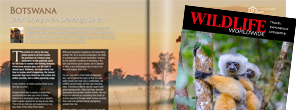Festival of Whales San Ignacio Lagoon, Baja California

After 30 years of travelling the world looking at wildlife and enjoying (almost) every moment of it, I have finally found the ultimate, the finest, the absolute pinnacle of wildlife viewing in the natural world - seeing grey whales in their calving and breeding grounds in Mexico’s San Ignacio Lagoon.
 After being decimated by 20th century whalers the grey whale population on the western side of the Pacific has been all but eliminated and it was not much different for the eastern Pacific population. However, amazingly the eastern Pacific population (or Californian grey whales) has recovered significantly and is know known to number in the region of 21,000 individuals. Every year after being born in San Ignacio Lagoon (and two others along the Baja peninsula) they embark upon the greatest mammal migration of all and head north hugging the coast of America and Canada to Alaska and the Chukchi Sea, not feeding until they get north of Monteray Bay. They spend the summer months consuming gigantic amounts of crustaceans and building up their strength and their fat reserves before heading back down to Baja and San Ignacio to arrive again in January of the following year. In all they travel 19,000 kilometres (or 12,000 miles) each and every year. Truly staggering as a statistic in itself, but even more so when you consider that for the three months of the year that they are in Baja California they don’t feed at all - why? - because there is nothing for them to feed on in the three key lagoons that they frequent.
After being decimated by 20th century whalers the grey whale population on the western side of the Pacific has been all but eliminated and it was not much different for the eastern Pacific population. However, amazingly the eastern Pacific population (or Californian grey whales) has recovered significantly and is know known to number in the region of 21,000 individuals. Every year after being born in San Ignacio Lagoon (and two others along the Baja peninsula) they embark upon the greatest mammal migration of all and head north hugging the coast of America and Canada to Alaska and the Chukchi Sea, not feeding until they get north of Monteray Bay. They spend the summer months consuming gigantic amounts of crustaceans and building up their strength and their fat reserves before heading back down to Baja and San Ignacio to arrive again in January of the following year. In all they travel 19,000 kilometres (or 12,000 miles) each and every year. Truly staggering as a statistic in itself, but even more so when you consider that for the three months of the year that they are in Baja California they don’t feed at all - why? - because there is nothing for them to feed on in the three key lagoons that they frequent.
So, what is so amazing about seeing the grey whales here?
 Well, for one, after having been decimated by whalers, who used to call them ‘devil fish’, because they fought so hard to stay alive (many whalers were killed) they seem to have forgiven us. Many of the whales that are being seen in the lagoon today are whales that were alive during the time of the intense whaling period - a time when they were needlessly harpooned by people from skiffs (small boats) about the the same size as the ones that we use for whale-watching. Secondly, not only do they allow us to see them at close quarters but they actively seek us out - the mothers bring their newly born young to the boat and lift them up on their backs or their bellies to see the boats and be caressed by us. They love to be splashed, they love their mouths stroked and their baleen plates touched, they love the sound of the whooping we make, and our song, our applause and happiness… and they come back for more and more and more. And if they come over for attention and you don’t give it to them, then what happens? Simple. They head over to a boat that will.
Well, for one, after having been decimated by whalers, who used to call them ‘devil fish’, because they fought so hard to stay alive (many whalers were killed) they seem to have forgiven us. Many of the whales that are being seen in the lagoon today are whales that were alive during the time of the intense whaling period - a time when they were needlessly harpooned by people from skiffs (small boats) about the the same size as the ones that we use for whale-watching. Secondly, not only do they allow us to see them at close quarters but they actively seek us out - the mothers bring their newly born young to the boat and lift them up on their backs or their bellies to see the boats and be caressed by us. They love to be splashed, they love their mouths stroked and their baleen plates touched, they love the sound of the whooping we make, and our song, our applause and happiness… and they come back for more and more and more. And if they come over for attention and you don’t give it to them, then what happens? Simple. They head over to a boat that will.
It is the only completely natural wildlife experience on earth where the mammals actively seek human attention and human touch - and so obviously enjoy it. It is extraordinary.
 It is not a contrived experience, nor does it lack regulation, in fact there are only a handful of camps in the lagoon area and whilst the camps combined owned a total of 26 boats, there is a strictly controlled, self-administered system that only allows 16 boats to be in the whale-watching zone at any one time. And even then, they are counted in by the sheriff (who notes precisely how many people there are on each vessel) and they can only be in the zone for a maximum of 90 minutes. The whale-watching zone covers a pretty small proportion of the lagoon itself and the whales have the entire area in which to roam, and the contact is entirely at the ‘request’ of the whales themselves, the boat drivers being true experts in their field.
It is not a contrived experience, nor does it lack regulation, in fact there are only a handful of camps in the lagoon area and whilst the camps combined owned a total of 26 boats, there is a strictly controlled, self-administered system that only allows 16 boats to be in the whale-watching zone at any one time. And even then, they are counted in by the sheriff (who notes precisely how many people there are on each vessel) and they can only be in the zone for a maximum of 90 minutes. The whale-watching zone covers a pretty small proportion of the lagoon itself and the whales have the entire area in which to roam, and the contact is entirely at the ‘request’ of the whales themselves, the boat drivers being true experts in their field.
If you only take one wildlife holiday in your life, this is the one you must do - it will change your life forever.

Why not join me on our next whale watching trip to Baja, California and experience it for yourself… or give me a call or drop me an email, and I will happily chat to you about the options available to you. It's also worthwhile reading Simon Barnes' recent article about this trip in The Times.








